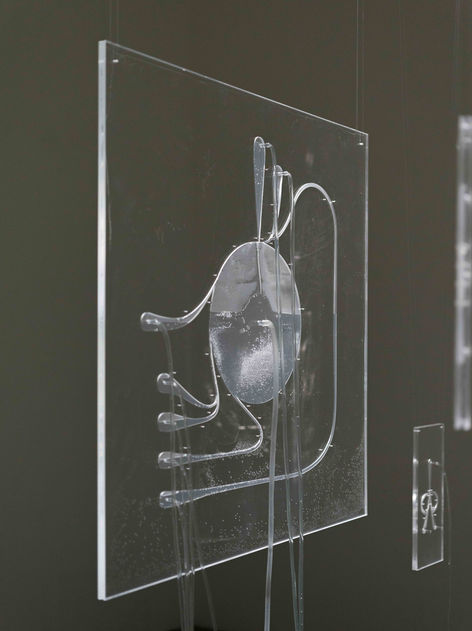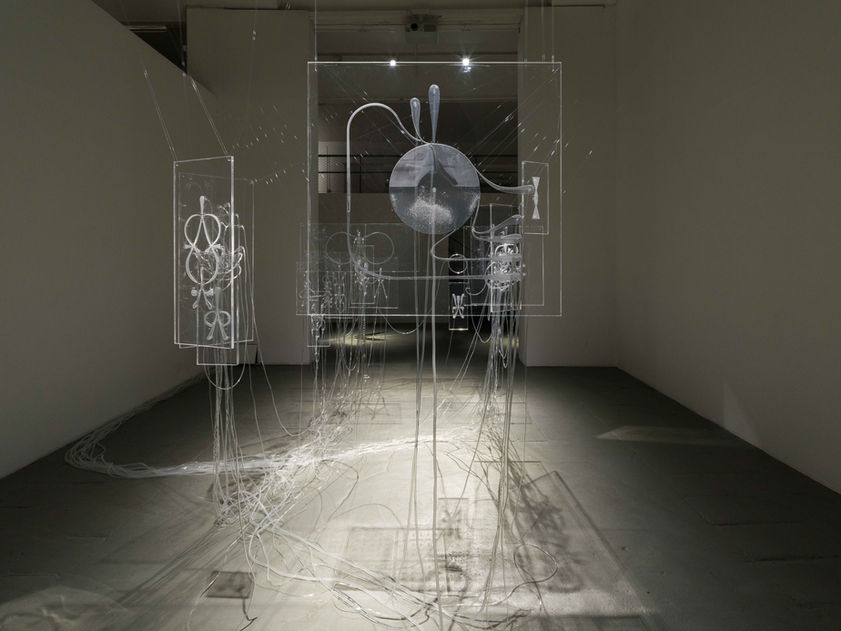
Fluid Anatomy
late 2024 - sound installation with water & air / acryl glass plates
Produced & Curated by singuhr projekte
Supported by: Musikfonds, Bezirksamt Pankow, Berlin
Technical support: Dorian Largen, Jan Rohmer, FabLab.ro
Special thanks for research support: Benjamin Bühling
Presented at: Meinblau Projektraum
Fluid Anatomy is a purely analogue system powered only through water and air, based on components and circuits from fluid mechanics. The installation implements a fluidic model in which water and air carry information. This fluidic computer fills the entire space with its swirls, pulsating fluids and vibrations.
Fluidics, also known as fluid logic, is a research field established in the 1950s that uses fluid jets to perform operations similar to those achieved through electronics. In fluidics, form follows function, curved intricate cavities become switches that can resist radiation and environmental decay. Such shapes were sent into space, powered automation machines (Soviet Volga Jet System) and heart valves. 1964 saw the first fluid digital computer FLODAC released by Univac. These circuits were still slow compared to their electronic counterparts and in a time where speed became key, fluidics lost itself in history.
Focusing on fluidics as an alternative to electronics, ‘Fluid Anatomy’ unravels a forgotten parallel history to highlight the beauty and resilience of computers that become fluid. The installation exposes more than 20 shapes restored and transformed from old patents and archives. These lost and found circuits reanimate a technology that does not want to become faster but rather attuned to water and air movements. It appears as if their humanesque form defies the rectangularity of electronic circuit boards.
The stream makes its way, pumped throughout a branching system of tubes. As it enters the geometries, its path is deflected by the Coanda effect. This physical phenomenon notes that jets tend to attach to convex surfaces, curves attract and therefore can deviate a stream. Each shape forms a cavity comprised of attentively placed contours that move the path from side to side. Input sensors trace the presence and absence of water and air. A large Oscillator with long feedback paths clocks the system. A pulse shaper circuit creates vibration. Jets are Counted (in a Binary Counter), memorised (in a Shift Register), compared (in a Comparator), reduced (in a Subtraction circuit) and joined in a final Summer. Parallel air paths control diverse oscillators which resound in cascaded whistled frequencies.
The installation pursues these riveting morphologies in a large circuitry that rests in a state of feedback as everything recirculates. All calculations are made transparent through plates of acrylic glass and tubes. As the installation passes from one rhythmic pattern to another, the public is invited to walk amongst fluidic bodies and listen to the subtle sounds that water and air produce.











































